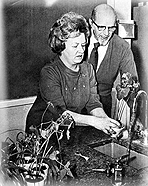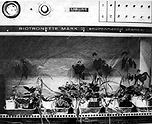Acoustic fertilizer ?
The Plant Experiments
In 1973, a woman named Dorothy Retallack published a small book called The Sound of Music and Plants. Her book detailed experiments that she had been conducting at the Colorado Woman’s College in Denver using the school’s three Biotronic Control Chambers. Mrs. Retallack placed plants in each chamber and speakers through which she played sounds and particular styles of music. She watched the plants and recorded their progress daily. She was astounded at what she discovered.
Her first experiment was to simply play a constant tone. In the first of the three chambers, she played a steady tone continuously for eight hours. In the second, she played the tone for three hours intermittently, and in the third chamber, she played no tone at all. The plants in the first chamber, with the constant tone, died within fourteen days. The plants in the second chamber grew abundantly and were extremely healthy, even more so than the plants in the third chamber. This was a very interesting outcome, very similar to the results that were obtained from experiments performed by the Muzak Corporation in the early 1940s to determine the effect of "background music" on factory workers. When music was played continuously, the workers were more fatigued and less productive, when played for several hours only, several times a day, the workers were more productive, and more alert and attentive than when no music was played.
|
| Dorothy Retallack and Professor Broman working with the plants used in music experiments. |
For her next experiment, Mrs. Retallack used two chambers (and fresh plants). She placed radios in each chamber. In one chamber, the radio was tuned to a local rock station, and in the other the radio played a station that featured soothing "middle-of-the-road" music. Only three hours of music was played in each chamber. On the fifth day, she began noticing drastic changes. In the chamber with the soothing music, the plants were growing healthily and their stems were starting to bend towards the radio! In the rock chamber, half the plants had small leaves and had grown gangly, while the others were stunted. After two weeks, the plants in the soothing-music chamber were uniform in size, lush and green, and were leaning between 15 and 20 degrees toward the radio. The plants in the rock chamber had grown extremely tall and were drooping, the blooms had faded and the stems were bending away from the radio. On the sixteenth day, all but a few plants in the rock chamber were in the last stages of dying. In the other chamber, the plants were alive, beautiful, and growing abundantly.
|
| "Chaos, pure chaos": plants subjected to Led Zeppelin and Jimi Hendrix didn't survive |
Mrs. Retallack’s next experiment was to create a tape of rock music by Jimi Hendrix, Vanilla Fudge, and Led Zeppelin. Again, the plants turned away from the music. Thinking maybe it was the percussion in the rock music that was causing the plants to lean away from the speakers, she performed an experiment playing a song that was performed on steel drums. The plants in this experiment leaned just slightly away from the speaker; however not as extremely as did the plants in the rock chambers. When she performed the experiment again, this time with the same song played by strings, the plants bent towards the speaker.
Next Mrs. Retallack tried another experiment again using the three chambers. In one chamber she played North Indian classical music performed by sitar and tabla, in another she played Bach organ music, and in the third, no music was played. The plants "liked" the North Indian classical music the best. In both the Bach and sitar chambers, the plants leaned toward the speakers, but he plants in the Indian music chamber leaned toward the speakers the most.
She went on to experiment with other types of music. The plants showed no reaction at all to country and western music, similarly to those in silent chambers. However, the plants "liked" the jazz that she played them. She tried an experiment using rock in one chamber, and "modern" (dischordant) classical music of negative composers Arnold Schönberg and Anton Webern in another. The plants in the rock chamber leaned 30 to 70 degrees away from the speakers and the plants in the modern classical chamber leaned 10 to 15 degrees away.
I spoke with Mrs. Retallack about her experiments a few years after her book was published, and at that time I began performing my own experiments with plants using a wood-frame and clear-plastic-covered structure that I had built in my back yard. For one month, I played three-hours-a-day of music from Arnold Schönberg’s negative opera Moses and Aaron, and for another month I played three-hours-a-day of the positive music of Palestrina. The effects were clear. The plants subjected to Schönberg died. The plants that listened to Palestrina flourished.
In these experiments, albeit basic and not fully scientific, we have the genesis of a theory of positive and negative music. What is it that causes the plants to thrive or die, to grow bending toward a source of sound or away from it?
Tags:
Replies to This Discussion
-
Permalink Reply by Vlad Jovanovic on February 10, 2012 at 11:45am
-
And here I thought I was sadistic with "Safety Second Body Last"...(probably much better than Mozart even for making your kids smarter in todays day and age).
Many of us probably, would like to see the results of such an experiment... Then maybe have the Guild of Deaf Plant Biologists try to repeat the results just to how the ESP angle pans out? Her reports do seem really quite dramatic...70 degree angles! Those plants must have been some real Svengali's too pick up on her bias to such degree.
-
Permalink Reply by Alexandre Letellier on February 10, 2012 at 11:19pm
-
Vlad Jovanovic said:
Do you happen to know if Mrs. Retallak played the music exclusively while the lights were on, or during 'dark' time, or both?
I have no other info on Mrs Retallak than what I posted in the OP. Can't find the book in pdf anywhere, and it's sold $105 at amazon so I don't think it's worth it. I found many recent and more rigorous studies anyway. The consensus is very much that classical music OR sine tone favor all stages of growth, from germination to fruiting. It's actually quite impressive and not a marginal benefit at all. For example, French scientists have grown 2Kg tomatoes with music and the British did a 13Kg beet :)
One study also found an increase in the amount of nutrients (up to 92%), as well as accelerated ripening and heavier fresh weight (up to 30%) in tomatoes. Another study was monitoring the health of the plant by measuring the photosynthesis efficiency and also found positive results.
The thing is that all studies confirm positive effects but the process by which it happens has not been proved yet.
As for the Rock versus Jazz/classical thing it doesn't have to be ESP. It is a physical fact that rock and some modern classical composers uses disharmonious frequencies. That has nothing to do with someone enjoying the music or not. Dissonances (modern classical) and distortion (rock) are physical parameters that you can measure with a freeware nowadays. Plants are vibrating when subjected to sound waves just like any other objects, so it isn't such a surprise that dissonant/distorted waves could impair their development and that harmonious/consonant/sine could favor it.
I'm just trying to present an Occam's razor shaven explanation first but there might be more to it, like as you said ESP. Also if the effects are as impressive as these studies claim I might use it myself just for fun and because music is both my job and a passion. I'll have to do a couple experiments to really see it in action though...
-
Permalink Reply by Jon Parr on February 11, 2012 at 1:52am
-
I wonder if pandora has "plant growing" station. I bet they like the sound of wind and reeds and birds, like the music that plays while getting a massage.
-
Permalink Reply by Alexandre Letellier on February 11, 2012 at 2:16am
-
Actually your bet is spot on, another study I read was focusing on looking for favorable frequencies, rather than music, and they found that the best effects on growth where in the frequency range of birds songs ... Not surprising either once you realize that nature is integrated and symbiotic at a level way deeper than the level that we are just starting to understand :)
Anyway I find all this fascinating, what a place we live in !
-
Permalink Reply by Carey Ma on February 11, 2012 at 3:25am
-
What happened to my frikin post?...@#^@^@@$&^^$#!!!!
I'm off to Hong Kong, so hope to re-post after I return. Some fascinating info I want to share.
-
Permalink Reply by Jon Parr on February 11, 2012 at 3:31pm
-
Dunno, Carey, but now I'm anxious to read your repost. I've lost my share replies in this forum.
I wonder how reggae fares. After all, the plant inspired that music, maybe it inspires the plant.
-
Permalink Reply by Carey Ma on February 11, 2012 at 6:06pm
-
Reggae is one of the types of music I play for my ladies. May they live short and bud fruitful.
I couldn't log on last night and have to leave in 20 min for airport but gist of it is that I have experimented with different music and sounds. I too believe that nature provides clues to her symbiotic style. I foliar spray in the morning accompanied by recordings of insects transitioning to birdsong at sunrise. My hen's/ farm's daily routine is transitioned to different songs to trigger a Pavlov response.
More when I get back.
-
Permalink Reply by Pierre Riche on March 14, 2012 at 3:38pm
-
Great thread. It makes me think of Dr Masaru Emoto's work and book "The mesage from water" where he freezes water and photographs the crystaline structure. The results are astounding and corespond to the intention of the one doing the experiment. It proves that human consciousness effects the water that is around through some sort of psychic osmosis.
Perhaps our joy or dislike of the music is effecting the plants more than the music itsself. I've heard of plants thriving to punk rock which is very dischordant and violent. The farmer got allot of pleasure from this type of music so maybe that vibe was being picked up by the plant more so than the actual sound vibrations of the music.
I'd like to hear about an experiment with the same music on plants in two different controll spaces. The persons present should have opposing oppinions of the music being played. Now lets see how the plants react.
- ‹ Previous
- 1
- 2
- Next ›
© 2025 Created by Sylvia Bernstein.
Powered by
![]()

